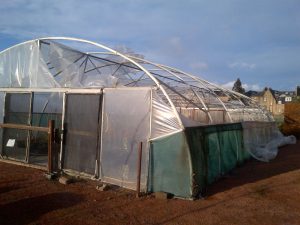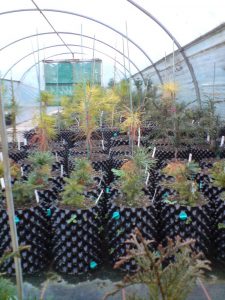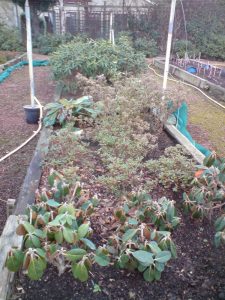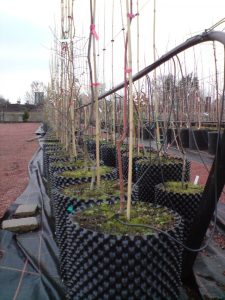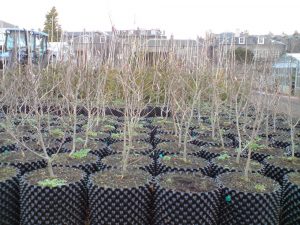Luckily the Nursery suffered less damage to its infrastructure than the main Garden. However, the skin of one of the largest tunnels was completely blown off. Fortunately, there was no damage to the plants inside. Many of you have asked if we have replacements for the trees that have been lost, the answers is yes we do. The Nursery holds a collection of new plants from our own expeditions and those of other botanic gardens; wild origin material from Index Seminum (the name for botanic garden seed lists) and propagations from existing plants. These will form the nucleus of new plantings in the coming year, as areas are cleared.
Amongst the most interesting, Sciadopitys verticillata, is a superb conifer with unusual broad needles. Collected in Japan (Nagano Prefecture: Nagisomachi: Nagisodake) from confierous forest growing on steep ridge running north south. Dominant trees Sciadopitys verticillata and Chamaecyparis obtusa with an understory of Disanthus cercidifolius, Enkianthus campanulatus and Rhododendron degronianum (Royal Botanic Garden Edinburgh Southern Japan Expedition 342. 5 Oct 2006). It may take a number of years to reach the 40meters that it is capable of in the wild.
The unfortunate consequence of fallen trees is the plants that they crush on the way down, Rhododendron beesianum, is one of may exiting new Rhododendrons that will help to re-green the Wild Garden next to the Rock Garden. It was collected in China (Yunnan: Gongshan: Zizhixian), along road from Gongshan to Kongdang. E side of Gaoligong Shan. SW facing slope. Cool temperate forest with Tsuga and Picea mixed with broadleaf evergreen trees. Growing on decomposing granite on steep slope below road. (Gaoligong Shan Biotic Survey Expedition – Autumn 2002 16519. 23 Sep 2002). It has large showy heads of pink flowers in the spring and will take about 10 years to reach a mature height of 3m.
Acer heldreichii, is a medium sized tree. It has a large range from the Balkans to SE Asia. With an architectural shape and attractive foliage that gives a good display of autumn colour, it will make a good replacement tree. The plant we have is wild collected in Turkey (North-east Anatolia: A8: Artvin) above Murgul; above Damar. Ziyaretçi Das. Degraded vegetation on steep mountain slopes above copper mine, with Picea orientalis and Sorbus aucuaparia co-dominant species (Turkey Darwin Initiative 85. 27 Oct 2005).
Staff were fortunate to meet Nori Shira on a collaborative expedition in Japan a few years ago. He has sent us seed of, Magnolia stellata from Japan (Honshu: Ikawadu, Tahara-shi, Aichi Pref) Near the bottom of a north facingMagnolia stellata slope. Grows in the boggy area from the spring water, around the edge of the woodland which is a secondary forest. With Cryptomerias, Arunus japonica and Heloniopsis orientalis underneath. Colony with about 100 plants. (Shira, Nori 17. 12 Oct 2007). Thought to be common in our gardens it is rare in the wild. These plants flowered for the first time in spring 2011 and they are beautifully suffuses with pink and slightly longer lasting than the white ones we usually see.
The nursery has over 3700 accessions waiting in the wings. It comes into it’s own for just such events, however, unfortunately it can not ‘stock’ the time that growth takes, that has been lost. Hopefully new expeditions will replace these plants in subsequent years. It will take many years before some parts of the Garden regain the feeling of maturity they did only a few weeks ago. (The Nursery is not open to the public).

